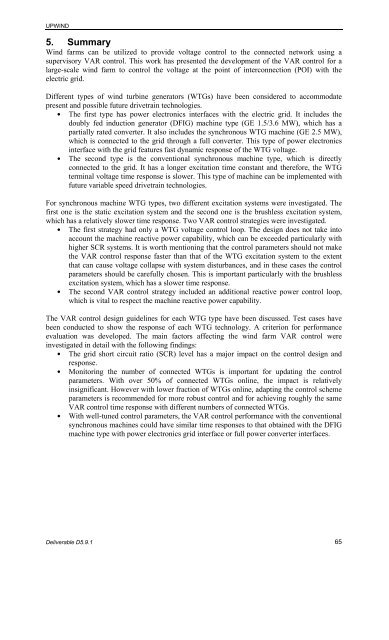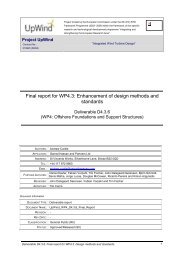Impact of Drivetrain on Wind Farm VAR Control - Upwind
Impact of Drivetrain on Wind Farm VAR Control - Upwind
Impact of Drivetrain on Wind Farm VAR Control - Upwind
You also want an ePaper? Increase the reach of your titles
YUMPU automatically turns print PDFs into web optimized ePapers that Google loves.
UPWIND<br />
5. Summary<br />
<strong>Wind</strong> farms can be utilized to provide voltage c<strong>on</strong>trol to the c<strong>on</strong>nected network using a<br />
supervisory <strong>VAR</strong> c<strong>on</strong>trol. This work has presented the development <str<strong>on</strong>g>of</str<strong>on</strong>g> the <strong>VAR</strong> c<strong>on</strong>trol for a<br />
large-scale wind farm to c<strong>on</strong>trol the voltage at the point <str<strong>on</strong>g>of</str<strong>on</strong>g> interc<strong>on</strong>necti<strong>on</strong> (POI) with the<br />
electric grid.<br />
Different types <str<strong>on</strong>g>of</str<strong>on</strong>g> wind turbine generators (WTGs) have been c<strong>on</strong>sidered to accommodate<br />
present and possible future drivetrain technologies.<br />
• The first type has power electr<strong>on</strong>ics interfaces with the electric grid. It includes the<br />
doubly fed inducti<strong>on</strong> generator (DFIG) machine type (GE 1.5/3.6 MW), which has a<br />
partially rated c<strong>on</strong>verter. It also includes the synchr<strong>on</strong>ous WTG machine (GE 2.5 MW),<br />
which is c<strong>on</strong>nected to the grid through a full c<strong>on</strong>verter. This type <str<strong>on</strong>g>of</str<strong>on</strong>g> power electr<strong>on</strong>ics<br />
interface with the grid features fast dynamic resp<strong>on</strong>se <str<strong>on</strong>g>of</str<strong>on</strong>g> the WTG voltage.<br />
• The sec<strong>on</strong>d type is the c<strong>on</strong>venti<strong>on</strong>al synchr<strong>on</strong>ous machine type, which is directly<br />
c<strong>on</strong>nected to the grid. It has a l<strong>on</strong>ger excitati<strong>on</strong> time c<strong>on</strong>stant and therefore, the WTG<br />
terminal voltage time resp<strong>on</strong>se is slower. This type <str<strong>on</strong>g>of</str<strong>on</strong>g> machine can be implemented with<br />
future variable speed drivetrain technologies.<br />
For synchr<strong>on</strong>ous machine WTG types, two different excitati<strong>on</strong> systems were investigated. The<br />
first <strong>on</strong>e is the static excitati<strong>on</strong> system and the sec<strong>on</strong>d <strong>on</strong>e is the brushless excitati<strong>on</strong> system,<br />
which has a relatively slower time resp<strong>on</strong>se. Two <strong>VAR</strong> c<strong>on</strong>trol strategies were investigated.<br />
• The first strategy had <strong>on</strong>ly a WTG voltage c<strong>on</strong>trol loop. The design does not take into<br />
account the machine reactive power capability, which can be exceeded particularly with<br />
higher SCR systems. It is worth menti<strong>on</strong>ing that the c<strong>on</strong>trol parameters should not make<br />
the <strong>VAR</strong> c<strong>on</strong>trol resp<strong>on</strong>se faster than that <str<strong>on</strong>g>of</str<strong>on</strong>g> the WTG excitati<strong>on</strong> system to the extent<br />
that can cause voltage collapse with system disturbances, and in these cases the c<strong>on</strong>trol<br />
parameters should be carefully chosen. This is important particularly with the brushless<br />
excitati<strong>on</strong> system, which has a slower time resp<strong>on</strong>se.<br />
• The sec<strong>on</strong>d <strong>VAR</strong> c<strong>on</strong>trol strategy included an additi<strong>on</strong>al reactive power c<strong>on</strong>trol loop,<br />
which is vital to respect the machine reactive power capability.<br />
The <strong>VAR</strong> c<strong>on</strong>trol design guidelines for each WTG type have been discussed. Test cases have<br />
been c<strong>on</strong>ducted to show the resp<strong>on</strong>se <str<strong>on</strong>g>of</str<strong>on</strong>g> each WTG technology. A criteri<strong>on</strong> for performance<br />
evaluati<strong>on</strong> was developed. The main factors affecting the wind farm <strong>VAR</strong> c<strong>on</strong>trol were<br />
investigated in detail with the following findings:<br />
• The grid short circuit ratio (SCR) level has a major impact <strong>on</strong> the c<strong>on</strong>trol design and<br />
resp<strong>on</strong>se.<br />
• M<strong>on</strong>itoring the number <str<strong>on</strong>g>of</str<strong>on</strong>g> c<strong>on</strong>nected WTGs is important for updating the c<strong>on</strong>trol<br />
parameters. With over 50% <str<strong>on</strong>g>of</str<strong>on</strong>g> c<strong>on</strong>nected WTGs <strong>on</strong>line, the impact is relatively<br />
insignificant. However with lower fracti<strong>on</strong> <str<strong>on</strong>g>of</str<strong>on</strong>g> WTGs <strong>on</strong>line, adapting the c<strong>on</strong>trol scheme<br />
parameters is recommended for more robust c<strong>on</strong>trol and for achieving roughly the same<br />
<strong>VAR</strong> c<strong>on</strong>trol time resp<strong>on</strong>se with different numbers <str<strong>on</strong>g>of</str<strong>on</strong>g> c<strong>on</strong>nected WTGs.<br />
• With well-tuned c<strong>on</strong>trol parameters, the <strong>VAR</strong> c<strong>on</strong>trol performance with the c<strong>on</strong>venti<strong>on</strong>al<br />
synchr<strong>on</strong>ous machines could have similar time resp<strong>on</strong>ses to that obtained with the DFIG<br />
machine type with power electr<strong>on</strong>ics grid interface or full power c<strong>on</strong>verter interfaces.<br />
Deliverable D5.9.1 65











